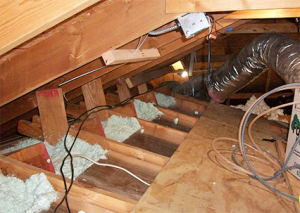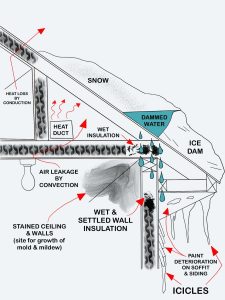Your attic – what you need to know
In our homes, we don’t often consider the space above our heads. But, whether you own or rent, an attic is a critical component to the structure and well-being of your home. To some, building a room in the roof is an intriguing concept; however, for most, an attic’s purpose is to insulate. We give you all you need to know about an attic, including if you want to make a room out of it.
What’s an attic?
If your house has a sloped roof but flat ceilings, then the space between the ceiling and roof is an attic.
Attics contain wood beams that support the roof of the house. The wood is framing that is either horizontal rafters or V-shaped or A-shaped trusses that support the roof itself. Inside, the drywall is screwed to the wood joists. Between the beams, you’ll find electrical wire connecting your lights as well as vent runs to and from your furnace. Finally, it also holds insulation to keep the conditioned air inside your home.
From the outside, most of the time, you see shingles, but you may see clay or metal cladding. Under the shingles is roofing felt paper or tar paper, and under the stapled tar paper is plywood, which is screwed down to the trusses or rafters. Within the attic space, you’ll find insulation, which helps to regulate the heat within your home. You may also see electrical wires, plumbing vent pipes, and furnace exhausts.
Are you looking for the best home insurance rate?
In less than 5 minutes, you can compare multiple home insurance quotes from Canada's top providers for free. Comparing rates online could save you hundreds of dollars.
What does an attic look like?
You may never have taken the time to look inside the attic of your home, but knowing its condition can save you money. The access to it is usually in a discreet place like a closet and will require the use of a ladder or chair to climb up. Pushing open the hatch, you’ll most likely find a space that runs the length and width of your home and contains nothing more than insulation and wood beams. Not exactly glamorous, but it serves an essential structural purpose. And if it isn’t properly maintained, it could cause you a lot of headaches.

House attic insulation
Hot air rises. Moisture falls. These two little facts can cause significant damage when it comes to your attic. If you have a leak on your roof, moisture can enter your attic. When the heat rises up into the attic, combined with the water, mould forms quickly. Water can also damage the drywall ceiling and weaken the wood beams supporting your roof.
In winter, if your attic isn’t adequately insulated, hot air will build up in the space, resulting in snow and ice on your roof melting. This can lead to “ice damming” under the roof shingles or in the eaves, resulting in significant damage to your roof.
If ice dams form, you’re looking at a hefty price tag to repair the damage. Your house insurance might pay for it, but coverage is not a maintenance policy, so you could be denied.

So, the best way to avoid ice damming is to ensure your roof is regularly maintained and your attic is adequately insulated. Signs that you have an ice dam include icicles (from slow-melting snow on your roof due to heat escape), and stained walls and ceilings from the water getting inside.
If you’re buying a new home, have a property inspector check the building beforehand. Being aware of a problem will help you with your offer on the house (i.e. offer less so you have money to pay for the necessary upgrades)
Sealing and venting attic space
You also want to make sure that your attic is sealed and vented. In your attic are openings for plumbing exhaust vents, fireplace chimneys (whether or not they’re still in use)electrical wires, and the attic door that provides access to it.
If the ins and outs aren’t correctly sealed, when you turn the heat or air conditioner on, you’ll be expending unnecessary energy. Your hard-earned money is going up in smoke. This will end up costing you on your hydro bill or gas bill, depending on your home’s heating system. And it can also cause moisture to build up in the space, leading to long-term problems.
A properly vented attic also helps to remove any moisture or hot that may build-up. As mentioned above, warm air building up in the winter can result in water damage. In the summer, a vented attic will aid in getting the hot air out of the space, therefore helping your air conditioner to run more efficiently.
How long does attic insulation last?
Generally, the insulation in your attic should last a lifetime. Depending on the attic insulation used, be it blown-in, batt insulation, or spray foam insulation, it could change. If your insulation is exposed to light, gets wet, or is punctured, cut, or burned, their lifespan is reduced. It’s another reason to ensure your attic and roof are receive regular maintenance. You don’t want to pay to have your entire attic re-insulated unnecessarily. And as explored above, without adequate insulation, you could end up facing any number of problems costing you more money.
Living in the attic
As a homeowner, you might want to make an attic living space. If this is the case, you’ll want to ensure that you have the appropriate attic living space requirements and carefully examine them before investing in your plan.
Questions when looking at converting an attic into more living space.
- Does it have enough height? Or will you have to raise your roof or lower your ceiling?
- Do the trusses provide enough support to sustain a room, or do you have to install new joists? Is the width or span of the room too wide, and will you need to use steel or LVL beams?
- How will you heat and cool the attic space? Do you need to move any mechanical components like ducting or venting?
- Is there enough room to add in a stairwell to access the attic room?
- If your attic has fibreglass insulation, you’ll more than likely need to re-insulate it – will you use batt insulation or spray foam?
- What about asbestos? If found, you’ll need a specialized asbestos removal service that will run into the thousands.
- Will you be installing a skylight?
All of these can be costly, and the price tag might make the dream renovation more of a nightmare.
If you’re thinking of turning your attic into an extra room, have a qualified contractor look ahead of time. In fact, long before you plan on the renovation – like 6-8 months. You’ll want to know what type of work you’ll need to undertake, the obstacles you may encounter, and of course, the price. If you’re making a structural change, changing ventilation, or moving an exhaust pipe, you’ll need a permit. If there are electrical changes, you’ll get a different permit.
It’s also a good idea to speak with your home insurance provider to find out how adding the room will affect your policy. You want insurance in place for any renovation. If your home’s value increases, you should insure it for that amount. Install a skylight? They can leak. What kind of flood insurance do you have on your policy?
Are you looking for the best home insurance rate?
In less than 5 minutes, you can compare multiple home insurance quotes from Canada's top providers for free. Comparing rates online could save you hundreds of dollars.
You’ll also need to ensure that the new space meets all the provincial fire and safety standards and is compliant with your municipality’s by-laws. Should your house increase in height, you may need a variance with your permit application.
If you would like to convert yours into a rentable room or space for a nanny or ageing parents, make sure your home insurance company is aware. However, if renting out your attic space, make tenant insurance a mandatory condition of rental. If there’s any damage caused to your attic, the impact to your home could be severe.
After weighing the pros and cons of converting your attic space into an extra room, review different home insurance policies. Take the time to compare home insurance plans. Your policy may cost you more with an extra room in your house, however, any improvements you make to your attic’s insulation and the structure of the overall building could lessen the impact of these costs. It will undoubtedly ease an anxious mind.
The Bottom Line
Your house attic is an essential part of your home – a toque in winter, an umbrella in spring, and shade in the hot summers. Whether you want extra space or the cozy blanket for your home, making sure it’s in good shape can prevent many problems for years to come.
ALSO READ